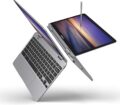Understanding Laptop Specifications: What Do They Really Mean?
When you’re shopping for a laptop, you’ll often come across a bunch of technical terms and numbers that might seem confusing. Words like “processor,” “RAM,” and “storage” can sound like a foreign language if you’re not familiar with them. But don’t worry! Understanding these specifications is easier than you might think, and knowing what they mean can help you pick the best laptop for your needs. Let’s break down some of the key terms you’ll encounter.
1. Processor (CPU)
The processor, also known as the CPU (Central Processing Unit), is like the brain of your laptop. It’s responsible for running programs and performing tasks. When you see terms like “Intel Core i5” or “AMD Ryzen 7,” those are different types of processors. Generally, a higher number or newer generation means better performance. If you’re just browsing the web and using simple programs, an i3 or Ryzen 3 will work fine. For gaming or video editing, you might want something more powerful like an i7 or Ryzen 7.
2. RAM (Memory)
RAM stands for Random Access Memory. Think of RAM as the short-term memory of your laptop. It’s where your laptop keeps data it’s currently using so it can access it quickly. More RAM means your laptop can handle more tasks at once without slowing down. For everyday tasks like browsing or word processing, 8GB of RAM is usually enough. If you’re doing more intensive work like video editing or running multiple applications at the same time, you might want 16GB or more.
3. Storage
Storage is where all your files, programs, and operating system are kept. There are two main types of storage: HDD (Hard Disk Drive) and SSD (Solid State Drive).
- HDD: This is an older type of storage that uses spinning disks to read and write data. It’s usually cheaper and offers more space, but it’s slower compared to SSDs.
- SSD: This is a newer type of storage that’s much faster because it doesn’t have moving parts. Your laptop will boot up quicker and programs will load faster with an SSD. It might be a bit more expensive, but it’s worth it for the speed.
4. Screen Size and Resolution
Screen size is measured diagonally from one corner to the opposite corner. Common sizes are 13, 15, and 17 inches. A larger screen is better for watching movies or working on detailed tasks, while a smaller screen is more portable and easier to carry around.
Resolution refers to how clear and sharp the image on your screen is. It’s measured in pixels, like 1920×1080 (also known as Full HD) or 2560×1440. The higher the resolution, the clearer the picture.
5. Battery Life
Battery life tells you how long your laptop will run on a single charge. If you’re on the go a lot, you’ll want a laptop with longer battery life. Manufacturers usually provide estimates, but actual battery life can vary depending on what you’re doing with your laptop.
6. Ports and Connectivity
Ports are the physical connections on your laptop where you plug in accessories like a mouse, USB drives, or headphones. Common ports include USB, HDMI (for connecting to a monitor), and headphone jacks. Connectivity refers to how your laptop connects to the internet and other devices. Most laptops have Wi-Fi and Bluetooth, but you might want to check which versions they support for the best performance.
By understanding these basic terms, you’ll be better equipped to choose a laptop that fits your needs. Remember, the best laptop for you depends on what you plan to use it for, so think about your priorities—whether it’s speed, storage, or portability—and use these specs to guide your decision.
